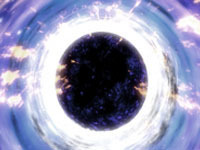Black hole devours stars for dinner
 Scientists have been long puzzling over the origin of the two giant X-rays bubbles arranged symmetrically around the Milky Way and discovered by astronomers in November of last year. Recently, a group of researchers proposed an explanation, relating these objects to a supermassive black hole at the center of our galaxy - the Sagittarius-A.
The bubbles filled with X-rays, whose diameter is approximately 25 thousand light years, were registered with the telescope "Fermi".
Scientists have been long puzzling over the origin of the two giant X-rays bubbles arranged symmetrically around the Milky Way and discovered by astronomers in November of last year. Recently, a group of researchers proposed an explanation, relating these objects to a supermassive black hole at the center of our galaxy - the Sagittarius-A.
The bubbles filled with X-rays, whose diameter is approximately 25 thousand light years, were registered with the telescope "Fermi".

It turned out that they are symmetrically located above and below the galactic disk, touching it at the center. This location led the astrophysicists to believe that their formation had to do with a supermassive black hole that is hypothetically located in the center of our Galaxy. In 1960, researchers found that less than 0.03 degrees from the center of the Milky Way there was a compact radio source that emits in the infrared also, X-ray and other ranges.
However, until the late 1960's no detailed studies of the galactic nuclei could be conducted due to the fact that it was hidden from the observers by dense interstellar dust clouds completely absorbing visible light. By the early 1970s, when it became possible to investigate the dynamic characteristics of the observed objects using devices operating in infrared light, the astrophysicists have found that Sagittarius A (this name was given to the object because of its proximity to the constellation of Sagittarius) has a complex spatial structure consisting of two diffused clouds located at a distance of 1 degree apart. The Eastern cloud (Sagittarius A) emits radio waves of non-thermal nature, while the Western cloud (Sagittarius A *) emits hot ionized gas.
Also read: Black holes hide whole civilizations
Observations carried out later by the international research group at the Max Planck Institute proved that it has a large mass. Soon, through the analysis of the orbital elements, scientists were able to clarify the details. It was approximately 4,31 ± 0,06 million solar masses, while the radius of the object was not more than 6.25 light-hours (or 45 astronomical units).
Initially there were speculations that the object may be a cluster of stars of low luminosity, neutron stars or low mass black holes. Later, scientists have concluded that by concentrating in a small volume, those in the short term would inevitably be merged into a single supermassive object. All the data suggested that it was a black hole surrounded by a cloud of radio-emitting hot gas with a diameter of approximately 1.8 parsecs.
In November of 2004, a black hole moving around Sagittarius A * at a distance of three light-years was discovered. The mass of the object is 1300 solar masses. In addition, a cluster of seven stars was registered, possibly the remnant of a more massive star cluster. The researchers concluded that while growing, the supermassive black holes absorb their "colleagues" of a smaller size and starts located in their vicinity.
It has been suggested that approximately once every thousand years, gravity Sagittarius A * grabs one of the nearest stars. As a result, part of the stellar matter falls into the black hole, and the other part is thrown into the space in the form of protons accelerated to enormous velocities. These protons, in turn, "attack" dust and gas particles around the black hole, causing them to emit streams of high-energy electrons. The latter, when in motion, emit photons in the radio and X-ray bands.
The fact that the boundaries of the aforementioned bubbles have sharp outlines fits the theory. In addition, it explains the excess of high-energy cosmic rays in the Galactic center. Researchers also believe that the "anomalies" in the center of the Milky Way may be the result of the collision of our galaxy with another dwarf with a black hole of 10,000 solar masses in the center.
It was pulled by the gravity of "our" black hole, and huge masses of matter falling back there contributed to the release of energy, which led to the formation of "gamma-bubbles." However, perhaps with the development of astronomical technology we will learn much more about the galactic center.
Irina Shlionskaya
Pravda.Ru
Subscribe to Pravda.Ru Telegram channel, Facebook, RSS!


